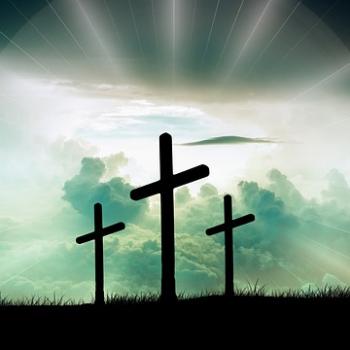
THE RELIGION GUY’S ANSWER:
During the formative first centuries of Christian history there were some 40 texts in circulation that could be considered “gospels,” according to one scholar, while another counted as many as 70. Marvin Meyer of Chapman University decided a dozen such non-biblical gospels merited inclusion in an 2005 anthology, while others have proposed different listings.
Early Christians dismissed what they judged to be “apocryphal” texts, meaning of doubtful authenticity, and recognized only the familiar quartet of Matthew, Mark, Luke and John as authoritative and eventually included in what became the New Testament. The Four did not name the authors, but the substance was deemed to come directly or indirectly from Jesus’ original apostles.
Some crucial dates
An obvious aspect of such judgments was the dating. Chronology expert Jack Finegan calculated that Jesus’ crucifixion probably occurred in early April of either A.D. 30 or 33. “The Oxford Bible Commentary” typifies experts’ consensus in listing these dates for the final composition of the Four: Matthew between A.D. 75 and 100. Mark “probably not long after” Jerusalem fell in 70. Luke most likely around 80 to 85. John about 90 to 100.
That means there would have been living eyewitnesses to Jesus to provide or confirm oral or written material incorporated into the Four, rather like historians in 2023 gathering memories about the Eisenhower presidency through the Reagan years.
But over the past generation, liberal scholarship has emphasized those “apocryphal” contenders, effectively reducing the exclusive stature of the biblical Four. Many decided there wasn’t much of importance to distinguish the traditional Four from the others. Elaine Pagels of Princeton University popularized the revisionist mood in “The Gnostic Gospels” (1979). By 2003, the big-selling and rather ridiculous novel “The Da Vinci Code” fictionalized the supposedly arbitrary choice of New Testament books as a power grab.
New-generation scholarship
Those interested in careful consideration of why the Four were favored can now consult the most substantive treatment of the issues in a generation, “The Gospel and the Gospels: Christian Proclamation and Early Jesus Books” (Eerdmans) by Simon Gathercole at England’s University of Cambridge. The 576-page tome, culminating two decades of research, needs 27 pages just to index the ancient manuscripts Gathercole cites.
Bart Ehrman of the University of North Carolina, who co-edited a 2011 anthology of “apocryphal” gospels, contends the actual history of early Christianity was “rewritten” to justify claims that the Four reflected “the views of the apostolic churches.” However, Gathercole sets out to show that the chosen Four contain the basic message that the earliest Christians heard and believed before the Four were even written and long before the competing “apocryphal” gospels appeared.
His starting point is Paul’s words in I Corinthians 15:3,4, with its summary of the original Christian message: “I handed on to you as of first importance what I in turn had received: that Christ died for our sins in accordance with the scriptures and that he was buried and that he was raised on the third day in accordance with the scriptures . . .” (New RSV updated edition). The passage goes on to record Jesus’ appearances after the resurrection, in one case to 500 people at the same time.
Paul wrote this letter two decades after the crucifixion, but said it records beliefs he had “received” after his Christian conversion experience, which Finegan put in the year 36. So at its first years of existence Christianity believed in 1) Jesus’s identity as Israel’s promised Messiah (or “Christ”), 2) his death having saving significance for sinners, 3) followed by his real bodily resurrection, 4) all of which fulfilled the Jewish Bible. The favored Four united on those same tenets.
Gathercole focuses on the seven most prominent “apocryphal” gospels, mostly known from 3rd and 4th Century manuscripts translated into the Coptic language and rediscovered in Egypt in 1945. However, he says the original versions were written far earlier, at various times between 140 and 200. He reports that each one omits or distorts Paul’s foundational tenets as follows.
Seven “Apocryphal” Gospels
Gospel of Thomas – The best-known of these seven texts repeats many of Jesus’s biblical sayings, so some even suppose it could have come before the biblical Gospels. All four points are obscured. There’s one reference to the crucifixion but only implicit and fuzzy on salvation, confusion on the resurrection, no “Christ” title, and a negative attitude that disregards the Jewish tradition. (And the work concludes with Jesus promising that “every female who makes herself male will enter the kingdom of heaven.”)
Gospel of Marcion – Unlike the other six, this text is reconstructed from quotations in treatises that opposed Marcion, a heretic excommunicated in 144. The work is largely a rewrite of Luke’s Gospel that demeans the Jewish tradition and its Creator God. Instead, there are two Christs from two deities, the future son of the justice-demanding God versus Jesus, who has already come as the son of the preferred God.
Gospel of Peter –Here it’s unclear whether Jesus (who is never named) was a messiah, or had any roots in Jewish history. On the cross, Jesus states that “my power” has been taken from his body, and as he says this he is “taken up” to heaven, without the death or ascension as depicted in the Bible. In the resurrection scene, two angels accompany a Jesus changed into massive size as the cross speaks in affirmation.
Gospel of Truth – This text typifies the Valentinian sect. Jesus is disconnected from the Jewish tradition with its messiahship. Interpreters disagree on whether or to what degree its death of Jesus was physical and real, though it does have saving significance. The ambiguity results from the fact that matter lacks reality and was the creation of Lady Error, an angry entity that afflicted Jesus on the cross. There is resurrection imagery but it may not be reality.
Gospel of Philip – Also Valentinian, the creation was the mistake of an inferior deity and the faith of the Jewish Bible is corrupt. However, the title of Christ is central. Again, at the crucifixion the spiritual essence of the savior ascends to the Father while his material body is left on the cross. “Philip” reverses the biblical events, so that Jesus first obtains resurrection, though perhaps not bodily, then followed by death.
Gospel of the Egyptians – This text typifies one form of the Gnostic movement with its plethora of gods. The Great Invisible Spirit emanates a trinity of Father, Mother, and Son, each in turn forming eight elements. Eventually the divine Seth, the author of this book, comes to earth fused with Jesus. The Spirit anoints the Great Christ who begets the Triple Male Child who begets the Child of the Child. And so forth. Amid this mythology there is no clear indication of the customary Jewish setting, messiah, death or resurrection.
Gospel of Judas – This rediscovered text provoked a fair amount of buzz when published in 2006. It turns the traditional four Gospels inside out. For instance, Jesus’s betrayer of the title becomes the only disciple who comprehends his true teachings. Here again there’s distaste for the Jewish tradition. “Christ” designates a demon, and the idea that Jesus might be resurrected is rejected.
Gathercole’s portraits show that these seven texts generally hover around secret knowledge bestowed only to an elite class, are non-Jewish or anti-Jewish, and usually neglect or radically recast the messiahship, crucifixion and resurrection tenets that Paul “received” in the mid-30s A.D. A choice must be made.













